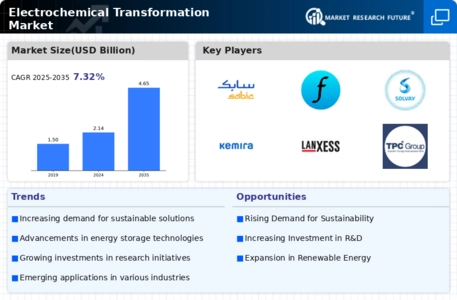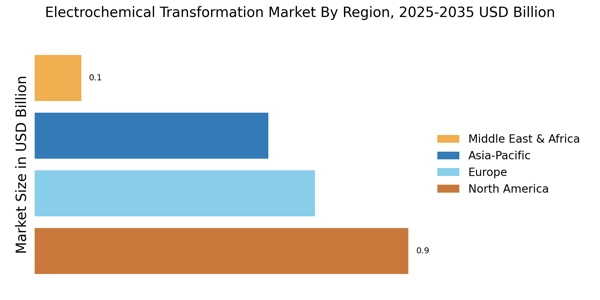Growing Industrial Applications
The Electrochemical Transformation Market is witnessing a rise in industrial applications, which is driving its growth. Industries such as chemical manufacturing, pharmaceuticals, and food processing are increasingly adopting electrochemical processes for various applications, including synthesis, purification, and energy recovery. The versatility of electrochemical technologies allows for more efficient and sustainable production methods, which are becoming essential in a competitive market. Moreover, the increasing focus on circular economy principles is prompting industries to explore electrochemical solutions for waste treatment and resource recovery. This trend is expected to expand the scope of the Electrochemical Transformation Market, as more sectors recognize the benefits of integrating electrochemical processes into their operations.
Government Initiatives and Funding
Government initiatives and funding are significantly influencing the Electrochemical Transformation Market. Many governments are recognizing the potential of electrochemical technologies in achieving energy transition goals and are investing heavily in research and development. For example, funding programs aimed at supporting innovative electrochemical projects are becoming more common, with billions allocated to enhance energy efficiency and reduce greenhouse gas emissions. This financial support not only fosters innovation but also encourages collaboration between public and private sectors. As a result, the Electrochemical Transformation Market is likely to benefit from increased investment, leading to accelerated advancements and wider adoption of electrochemical technologies.
Rising Demand for Clean Energy Solutions
The Electrochemical Transformation Market is experiencing a notable surge in demand for clean energy solutions. This trend is largely driven by the increasing awareness of environmental issues and the need for sustainable energy sources. As countries implement stricter regulations on carbon emissions, the adoption of electrochemical processes for energy conversion and storage is becoming more prevalent. For instance, the market for electrochemical energy storage systems is projected to grow significantly, with estimates suggesting a compound annual growth rate of over 20% in the coming years. This shift towards cleaner energy alternatives is likely to propel the Electrochemical Transformation Market forward, as businesses and governments seek innovative solutions to meet energy demands while minimizing environmental impact.
Increased Focus on Energy Storage Solutions
The Electrochemical Transformation Market is experiencing heightened interest in energy storage solutions, driven by the need for reliable and efficient energy systems. As renewable energy sources, such as solar and wind, become more prevalent, the demand for effective energy storage technologies is growing. Electrochemical energy storage systems, including batteries and supercapacitors, are emerging as viable options to address this need. Market data indicates that the battery segment alone is projected to reach a valuation of over 100 billion by 2030. This increasing focus on energy storage not only supports the integration of renewable energy but also enhances the overall stability of energy systems, thereby propelling the Electrochemical Transformation Market forward.
Technological Innovations in Electrochemical Processes
Technological advancements are playing a crucial role in shaping the Electrochemical Transformation Market. Innovations in materials science, such as the development of more efficient catalysts and electrodes, are enhancing the performance of electrochemical systems. These improvements not only increase the efficiency of energy conversion but also reduce costs associated with electrochemical processes. Furthermore, the integration of artificial intelligence and machine learning in optimizing electrochemical reactions is emerging as a game changer. As these technologies continue to evolve, they are expected to drive the growth of the Electrochemical Transformation Market, making it more competitive and accessible for various applications, including energy storage and conversion.


















Leave a Comment